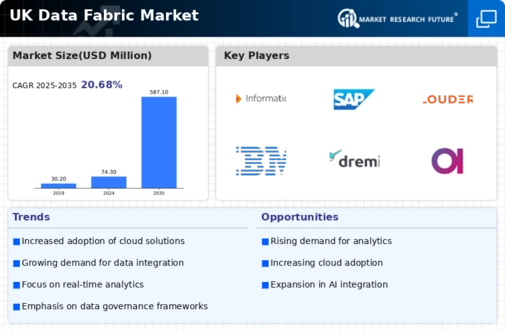Increased Focus on Data Security
In the context of the data fabric market, the emphasis on data security has intensified significantly. With the rise of cyber threats and stringent regulations, UK businesses are prioritising the protection of sensitive information. The data fabric market is responding by incorporating advanced security features, such as encryption and access controls, into their offerings. Recent reports suggest that the data security market is expected to reach £150 billion by 2026, highlighting the urgency for robust security measures. As organisations seek to comply with regulations like GDPR, the integration of security within data fabric solutions becomes essential. This focus on security not only protects data integrity but also fosters trust among consumers, thereby driving further adoption of data fabric technologies across various industries in the UK.
Shift Towards Hybrid IT Environments
The data fabric market is adapting to a notable shift towards hybrid IT environments among UK organisations. As businesses increasingly adopt a mix of on-premises and cloud-based solutions, the need for data fabric technologies that can seamlessly operate across these environments becomes critical. This trend is supported by the fact that approximately 70% of UK enterprises are expected to implement hybrid cloud strategies by 2026. Data fabric solutions are designed to provide a unified approach to data management, enabling organisations to maintain control over their data while leveraging the flexibility of cloud resources. This adaptability not only enhances operational efficiency but also supports scalability, making the data fabric market an essential player in the evolving IT landscape of the UK.
Rising Demand for Real-Time Data Processing
The data fabric market is experiencing a notable surge in demand for real-time data processing capabilities. As businesses in the UK increasingly rely on timely insights to drive decision-making, the need for data fabric solutions that facilitate real-time analytics becomes paramount. According to recent estimates, the market for real-time data processing technologies is projected to grow at a CAGR of approximately 25% over the next five years. This growth is driven by sectors such as finance and retail, where immediate access to data can significantly enhance operational efficiency. Consequently, the data fabric market is adapting to meet these requirements, offering solutions that integrate seamlessly with existing infrastructures while ensuring data accuracy and speed. This trend indicates a shift towards more agile data management practices, positioning the data fabric market as a critical enabler of business agility in the UK.
Emergence of Advanced Analytics Capabilities
The data fabric market is evolving in response to the emergence of advanced analytics capabilities. As organisations in the UK seek to leverage data for strategic advantage, the demand for sophisticated analytics tools is on the rise. Data fabric solutions are increasingly incorporating features such as predictive analytics and machine learning, allowing businesses to derive deeper insights from their data. This shift is reflected in the projected growth of the analytics market, which is expected to reach £100 billion by 2025. The integration of advanced analytics within data fabric solutions not only enhances decision-making but also enables organisations to anticipate market trends and customer behaviours. Consequently, the data fabric market is becoming a pivotal component in the analytics landscape, driving innovation and competitive advantage for UK businesses.
Growing Need for Data Integration Across Silos
The data fabric market is witnessing a growing need for seamless data integration across various silos within organisations. As businesses in the UK accumulate vast amounts of data from disparate sources, the challenge of unifying this information becomes increasingly complex. Data fabric solutions are emerging as a vital tool to address this issue, enabling organisations to create a cohesive data ecosystem. Recent studies indicate that organisations that effectively integrate their data can achieve up to 30% higher operational efficiency. This trend underscores the importance of data fabric technologies in breaking down silos and facilitating a holistic view of data. By enabling better collaboration and data sharing, the data fabric market is positioned to play a crucial role in enhancing organisational performance and driving innovation in the UK.
























Leave a Comment